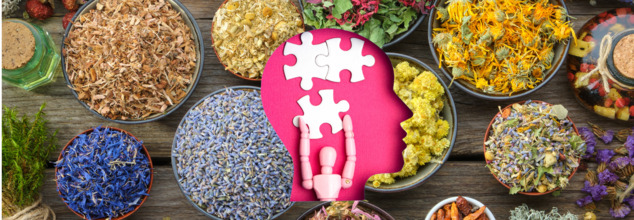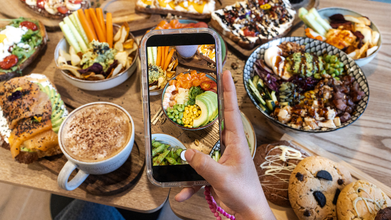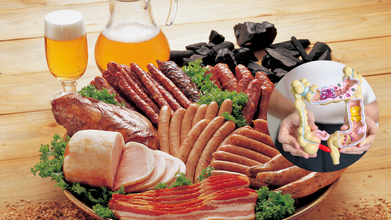- Health Conditions A-Z
- Health & Wellness
- Nutrition
- Fitness
- Health News
- Ayurveda
- Videos
- Medicine A-Z
- Parenting
How Can Ayurveda Balance Your Gut and Mind? Find Out

How Can Ayurveda Balance Your Gut and Mind? (Credit: Canva)
Ayurveda is a 5000 year old holistic healthcare science that emphasizes on the importance of holistic wellness – body, mind and emotions. It understands the impact your digestive health has on your mental health and vice versa.
In ayurveda, the core philosophy is Agni or digestive fire, which plays a crucial role in improving our physical health and also our ability to process emotions, and mental faculties. A strong agni allows us to maintain healthy mental clarity, while weak agni can lead to digestive health issues, which then impacts our emotional state and mental health.
Our gut is connected to our mind through a direct neurosis that sends messages every micro million second. It is important that our gut is healthy, clean and toxin free, to allow healthy signals to be transmitted back to the brain.
When our gut health is impacted, it signifies vata and pitta imbalance. Vata is dominant in the large intestine and colon, and when vata is imbalanced it causes bloating, indigestion, gas, flatulence, constipation, and colon health issues. An unhealthy colon can itself trigger 90% of our ailments and chronic diseases right from constipation to cancer, cold to clinical depression.
Pitta is dominant in our stomach and small intestine, and pitta imbalance can trigger burning sensation, acidity, reflux, digestive health issues and even IBS and diarrhoea.
Each dosha has a direct impact on our mental state as well. When vata is imbalanced it leads to colon health issues and also triggers anxiety, overthinking, worry and fear in the mind. Pitta imbalance leads to stomach issues and triggers anger, irritability, restlessness in the mind.
How can you better maintain your gut health and mental health?
The best way is through nutritious foods and eating the correct diet that has been tailormade for your individual prakriti.
Consume fresh, seasonal and local foods that allows your body to acclimatise to the local topographic region and the regional bacteria. This improves your gut flora, and digestive health. It improves your circadian rhythm too, as you sync yourself to your natural flora and fauna.
You can also consume gut friendly spices like turmeric which helps reduce inflammation, while cumin seeds, fennel seeds are carminative which improves digestion. Be conscious of your eating habits, and eat only 80% of your appetite.
Eat only when hungry and ensure to sit down peacefully for a meal without any technology or distractions. This allows you to better digest food, absorb nutrients and improve your energy levels too.
You must also walk 100 steps after every meal to aid digestion and ensure to engage in physical activity everyday which improves your blood circulation and elimination of waste.
Ayurveda understands that the gut, is called the second brain, as its directly linked to the central nervous system via the vagus nerve. This vagus nerve is responsible for the bidirectional communication between gut health and mental health. Impaired gut health will lead to digestive health issues and psychosomatic imbalances too.
You can also engage in yoga, meditation practices that improves your ability to stay calm, relaxed and enhance your gut health as well as mental health.
Gen Zs Are 62% More Likely To Overeat Food Even If They Are Full, Study Explains Why

(Credit - Canva)
A new study has revealed that Gen Zs eat much more ultra-processed foods than we may think. Processed foods have saturated the market over the years, however, recent researches have revealed how these foods affect our health. But do you know who is most affected by this? The study, done by the Virginia Tech, showed that not only are gen Zs more likely to overeat, but most of their diet is also affected by processed foods.
Research suggests about 62% of their total calories come from these factory-made items. A new study from Virginia Tech warns that this high intake, especially when it leads to overeating, is a major concern for their future health.
How Much UPFs and Calorie Intake?
Researchers at Virginia Tech looked at 27 young men and women, aged 18 to 25. For the study, the volunteers followed two different eating plans:
High-UPF Diet
81% of the calories came from ultra-processed foods.
Junk-Free Diet
A whole-food diet with no junk food.
The diets were strictly controlled and matched for things like fiber, sugar, and fat content to make sure the researchers were measuring the effect of processing alone, not just the nutrients. Each participant followed one diet for two weeks, took a break, and then switched to the other diet for two weeks.
Why Are Ultra-Processed Foods Bad?
According to John Hopkins University, Ultra-Processed Foods (UPFs) contains ingredients you wouldn't find in a home kitchen. These include chemical-based preservatives, industrial emulsifiers (like certain oils), high-intensity sweeteners (like high-fructose corn syrup), and artificial colors and flavors.
Furthermore, UPFs undergo intense factory processing techniques like molding, extrusion, and chemical alteration. The final product often bears almost no resemblance to the original ingredients it came from.
Common examples of UPFs include soda, packaged snacks (chips, cookies), candy, boxed macaroni and cheese, frozen ready-to-eat meals, lunch meats, and hot dogs.
Why Are Younger Gen Zs Are Overeating?
After following each two-week diet, the participants were given a breakfast buffet and allowed to eat as much or as little as they wanted. The researchers noticed a key difference based on age:
Ages 18 to 21
This younger group consumed significantly more calories during the buffet, especially after eating the high-UPF diet for two weeks. They were also more likely to gorge themselves even when they weren't hungry.
Ages 22 to 25
This older group ate less and did not show the same tendency to overeat.
The study suggests that being a younger adult may be a risk factor for eating too many calories after being exposed to a high-UPF diet. This indicates that the younger participants may be more influenced by the strong, appealing nature of junk food.
How Much Health Risks Do UPFs Pose?
The lead researcher noted that even though this was a short-term trial, if this kind of increased calorie intake continues over time, it will almost certainly lead to weight gain in these young people.
The findings are especially concerning because UPFs have already been linked to 32 negative health issues, including higher risks of heart disease, cancer, Type 2 diabetes, and mental health problems. Experts predict that if drastic measures are not taken, a third of Americans aged 15 to 24 could meet the criteria for obesity by 2050.
India Sees a 4000% Increase In Sale Of Ultra Processed Food, Finds Lancet Study

Credits: Canva
The latest Lancet Study warns that India is experiencing a rapid and worrying rise in the consumption of ultra-processed foods (UPFs). The UPF includes food like instant noodles, packaged snacks, ready-to-eat meals, sugary beverages, mass-produced breads, processed meats, and other industrially formulated products.
The paper was authored by 43 global experts who noted that traditional Indian meals are increasingly being replaced by convenient but nutritionally poor foods, which are not contributing to a rise in chronic diseases.
The Series calls for “immediate and decisive public health action”, stressing that individual willpower alone cannot fix dietary patterns. Instead, the availability, affordability, marketing, and widespread promotion of UPFs must be addressed at the policy level.
The Rate Of UPFs Growth In India
The shift has been dramatic. The retail sales of UPFs in India jumped from ₹7,996 crore in 2006 to ₹3.3 lakh crore in 2019. In other words, the initial value for the same products in 2006 was less than $ 0.9 Billion and by 2019, it reached the value of $ 38 Billion, leading to a forty-fold rise, or an increase around 4000%. This reflects a massive surge of how deeply these products have entered the Indian household.
During the same period, obesity rates among both men and women have doubled. Today, nearly one in four Indians is obese, one in ten has diabetes, and one in three has abdominal obesity. Childhood obesity has also risen, increasing from 2.1% to 3.4% between 2016 and 2019–21. The authors warn that this pattern mirrors global trends where UPF consumption is strongly linked to weight gain and metabolic disorders.
According to the papers, the UPF industry is a central driver of this shift. Because UPFs are more profitable than minimally processed foods, corporations invest heavily in their production, distribution, and marketing. This profit-focused model encourages continuous expansion, making these foods widely accessible and aggressively promoted.
why Is This Happening In India?
The Lancet Series highlighted that the major concerns are due to corporate influence and gap in India's food regulation. The marketing network of corporate influence often delay or weaken public health policies.
They uses strategies like direct lobbying and political pressure, involvement in the government committees, litigation to block regulations, funding research that creates doubt or shifts the blames and influence public opinion through advertising and public relation campaigns.
“UPFs are advertised addictions. A ban on their advertising and sponsorship is needed,” said Prof. Srinath Reddy, Chancellor of PHFI University of Public Health Sciences to The Tribune.
What Are The Health Impacts?
The authors emphasize that the harm caused by UPFs extends far beyond poor nutrition. Industrial processes, such as chemical modification, extrusion, and the addition of synthetic ingredients, can alter food structure in ways that negatively affect metabolism, immunity, and long-term health.
Regular consumption of UPFs has been linked to higher risks of obesity, Type-2 diabetes, cardiovascular disease, depression, and premature death. “These foods contribute to diminished immunity, aggravated inflammation, and a rise in life-threatening chronic diseases,” Dr. Reddy said.
After Lancet Links Ultra-Processed Foods to Organ Damage, New Study Ties Them to Bowel Polyps in Women Under 50

Credits: Canva
Health and Me previously reported on the latest Lancet Study, which is world's largest review, as per the Lancet that links consumption of ultra-processed food (UPF) with harm in every major organ system in the human body. A new study published in Jama Oncology by Andre T Chan, also cited on The Lancet Oncology now links the consumption of UPF with bowel polyps in women younger than 50 years. The study notes that these women are at a 45% increased risk of developing bowel polyps, which can further develop into colorectal cancer.
What Are Ultra Processed Foods?
UPFs are modern, highly engineered products that are made from cheap industrial ingredients like hydrogenated oils, protein isolates, and glucose or fructose syrups. They are also combined with cosmetic additives like dyes, artificial sweeteners, and emulsifiers. These foods are intentionally formulated to be hyper-palatable, and profitable. This is why UPFs are easily able to replace fresh or minimally processed food and traditionally home cooked meals around the world.
Also Read: China’s ‘Zombie Cell’ Pill Claims To Extend Human Life To 150—Could It Work?
What Did The Study Find?
The new findings come from the Nurses' Health Study II, which is a long-running US Cohort involving female registered nurses.
This analysis followed participants from 1991 to 2015, examining whether UPF consumption was linked to early-onset colorectal cancer (EOCRC) precursors. Every four years, participants completed detailed food-frequency questionnaires, which researchers used to calculate UPF intake based on the Nova classification system, a widely used framework that categorizes foods by degree and purpose of processing.
According to the questionnaires, the biggest contributors to UPF intake were ultra-processed breads and breakfast items (23%), sauces and condiments (22%), and sugar-sweetened or artificially sweetened beverages (20%).
Researchers assessed two types of EOCRC precursors: conventional adenomas (polyps) and serrated lesions, both of which were verified through medical and pathology records.
Over 24 years, among 29,105 women with an average age of 45, the study recorded 1,189 adenomas and 1,598 serrated lesions. The data revealed that women in the highest UPF consumption group, where UPFs made up 42% of daily calories, had a 45% higher risk of developing conventional adenomas compared to those in the lowest intake group (23% of daily calories). The median UPF intake across the cohort was 35% of total calories.
How Can UPFs Increase Polyp Risk?
Chan, speaking to The Lancet Oncology explained that UPFs may impair the gut’s protective barrier or disrupt the intestinal lining, triggering inflammation and reducing the gut’s ability to repair itself, conditions that may encourage tumor development.
The authors offer a possible explanation for why only adenomas, not serrated lesions, were associated with UPFs. They suggest that mechanisms linked to UPFs, such as microbiome disruption, inflammatory signalling, and diet-related genotoxins, may accelerate polyp formation, especially in younger individuals.
What makes these study even more relevant is that the study arrives after The Lancet has released a major three-paper series on UPFs and health, with many calling the need for action to be similar to the historic action against the tobacco industry.
© 2024 Bennett, Coleman & Company Limited

